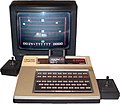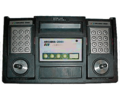Second generation of video game consoles
| Part of a series on the |
| History of video games |
|---|
The second generation of video game consoles lasted from 1976 until 1984.
Early 8-bit home consoles (1976-1983)

The earliest console, the Magnavox Odyssey, had used removeable cartridges that were nothing but glorified jumpers to activate the games already wired in to the console. This method was soon replaced during the move to PONG consoles, where the logic for one or more games was hardcoded into microchips using discrete logic, and no additional games could ever be added. By the mid-1970's cartridges had returned with the move to CPU based consoles. With games now consisting of microprocessor based code, these games were burned onto ROM chips that were mounted inside plastic cartridge casings that could be plugged into slots on the console. When the cartridges were plugged in, the general-purpose microprocessors in the consoles read the cartridge memory and ran whatever program was stored there. Rather than being confined to a small selection of games included in the box, consumers could now amass libraries of game cartridges.
The Fairchild VES was the world's first CPU based video game console, introducing the cartridge based game code storage format. It was released by Fairchild Semiconductor in August 1976. When Atari released their VCS the next year, Fairchild quickly re-named it to the Fairchild Channel F.
In 1977, Atari released its CPU based console called the Video Computer System (VCS), later called Atari 2600. Nine games were designed and released for the holiday season. It would quickly become by far the most popular of all the early consoles.
In 1978 Magnavox released its CPU based console, the Odyssey 2, in the United States and Canada. Philips Electronics released this same game console as the Philips G7000 in many European countries. Although it never became as popular as Atari, it managed to sell several million units through 1983.
In 1979, Activision was created by disgruntled former Atari programmers. It was the first third-party developer of video games. Many new developers would follow their lead in succeeding years.
The next major entry was Intellivision, introduced by Mattel in 1980. Though chronologically coming long before the "16-bit era", the Intellivision had a unique processor with instructions that were 10 bits wide (allowing more instruction variety and potential speed), and registers 16 bits wide. The system rocketed to popularity alongside the 2600.
Though not the first system to challenge Atari, it was the first to pose a serious threat to Atari's dominance. A series of Intellivision TV ads featuring George Plimpton mercilessly attacked the Atari VCS's lesser capabilities with side-by-side game comparisons. Nevertheless, Atari held exclusive rights to most of the popular arcade game conversions of the day, and used this key segment to support their older hardware in the market. This game advantage and the difference in price between the machines meant that each year Atari sold more units than Intellivision, lengthening its lead despite inferior graphics. This need for price parity has influenced every console war since.
Unique among home systems of the time was the Vectrex, the only one to feature vector graphics and its own self contained display.
1982 saw the introduction of the Colecovision, an even more powerful machine. Its sales also took off, but the presence of three major consoles in the marketplace and a glut of poor quality games began to overcrowd retail shelves and erode consumers' interest in video games. Within a year this overcrowded market would crash.
The popularity of early consoles was strongly influenced by their ports of arcade games. The 2600 was the first with Space Invaders, and the Colecovision had Donkey Kong.
In 1982 the Emerson Arcadia 2001, and variants thereof, were released.
Early cartridges were 2 KB ROMs for Atari 2600 and 4 KB for Intellivision. This upper limit grew steadily from 1978 to 1983, up to 16 KB for Atari 2600 and Intellivision, 32 KB for Colecovision. Bank switching, a technique that allowed two different parts of the program to use the same memory addresses was required for the larger cartridges to work.
In the game consoles, high RAM prices at the time limited the RAM (memory) capacity of the systems to a tiny amount, often less than a Kilobyte. Although the cartridge size limit grew steadily, the RAM limit was part of the console itself and all games had to work within its constraints.
By 1982 a glut of consoles and, over-hyped game releases, and games from new third-party developers less well-prepared than Activision began to appear - overflowing the shelf capacity of toy stores.
In part because of these oversupplies, the video game industry crashed, starting from Christmas of 1982 and stretching through all of 1983. See the main article: Video game crash of 1983.
Early handheld game consoles
The first handheld game console with interchangeable cartridges was the Microvision designed by Smith Engineering, and distributed and sold by Milton-Bradley in 1979. Crippled by a small, fragile LCD display and a very narrow selection of games, it was discontinued two years later.
The Epoch Game Pocket Computer was released in Japan in 1984. The Game Pocket Computer featured an LCD screen with 75 X 64 resolution, and could produce graphics at about the same level as early Atari 2600 games. The system sold poorly, and as a result only 5 games were made for it.
Second generation systems
Consoles
-
Fairchild Channel F (1976-1977)
-
RCA Studio II (1977)
-
Color TV Game (Nintendo, 1977)
-
Atari 2600 (1977-1992)
-
Bally Astrocade (1977-1985)
-
Magnavox Odyssey² (1978-1984)
-
APF Imagination Machine (1979, APF-M1000 Component 1978)
-
Mattel Intellivision (1980-1984)
-
Epoch Cassette Vision (1981)
-
Atari 5200 (1982-1984)
-
Milton Bradley Vectrex (1982-1984)
-
Emerson Arcadia 2001 (1982-1983)
-
ColecoVision (1982-1984)
-
Sega SG-1000 (1983-1985)
Handheld consoles
-
Milton Bradley Microvision (1979-1981)
-
Epoch Game Pocket Computer (1984)
Other
-
Nintendo Game & Watch (1980-1991)
Video game franchises established during second generation
References
History of computer and video games










